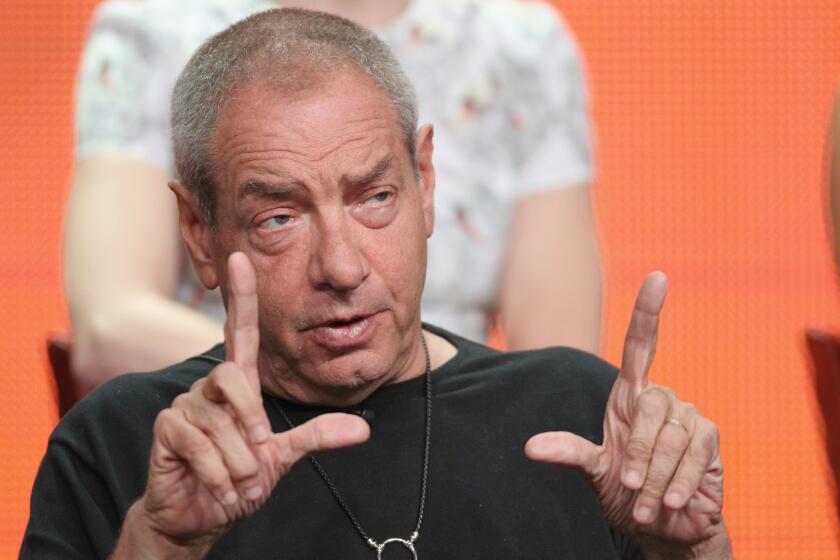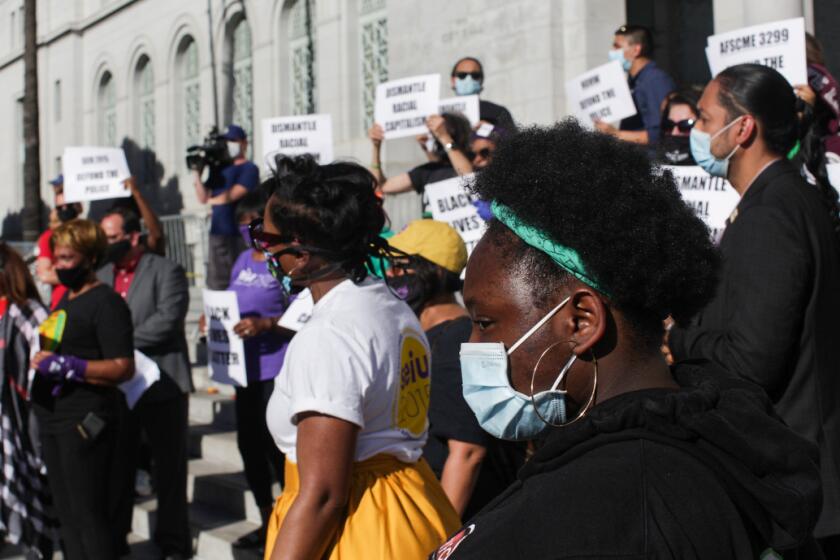A controversial Netflix show took on police in schools. It left one advocate in tears
Until last week, civil rights attorney Amir Whitaker had never watched Netflix’s “13 Reasons Why.” Jumping into the eighth episode of the final season without any context, he at first was disoriented — and amused — by the series’ trademark high-school melodrama.
Then he reached a development in the story that brought tears to his eyes: A student uprising against school resource officers (SROs) at the series’ fictional Liberty High, based in part on an ACLU study that Whitaker co-wrote to illustrate the negative effects on kids’ well-being of an abundance of police and few mental health resources.
“As it unfolded, and the students stood up and grabbed the bullhorn and started chanting, ‘No SROs’ and all that stuff, I literally got teary-eyed and was thinking, ‘Oh my gosh, this is on ... Netflix,’” Whitaker told The Times. “‘This is in pop culture now.’”
According to the streaming platform, the episode, “Acceptance/Rejection,” draws on the 2019 report “Cops and No Counselors,” which found that “there are more than 14 million students in schools with police but no counselor, nurse, psychologist or social worker.” The study was among more than 500 pages’ worth of research and reporting the writers of “13 Reasons Why” consulted on the subject, said Netflix, which stressed that the series is a dramatization, relying on fictionalized portrayals of real-world events.
Critics say the popular TV shows of “Law & Order,” “Chicago PD” and “FBI” creator Dick Wolf create harmful misperceptions of the criminal justice system.
“We started writing the season by asking how Liberty High would respond to everything that’s happened at their school,” the “13 Reasons Why” writers said in a joint statement to The Times. “We researched what schools have implemented to make campuses ‘safer,’ and we chose to have Liberty institute many of those measures. And then we explored the conflict that emerged, at Liberty as it often has in real life, between young people and the adults who are trying to protect them with measures that may be overly stringent, eroding of trust, or even harmfully misguided.
“We were informed and terribly troubled” by the ACLU report’s findings, the statement continued. “And this goes right to the heart of the problems at Liberty High School: This is a troubled, traumatized community that is over-policed at the cost of services that might truly help things get better.”
Released June 5, the final season of “13 Reasons Why,” which sparked controversy for its handling of teen suicide in Season 1, landed as protesters across the country demanded the removal of law enforcement from schools and other community spaces in response to the recent killings of Breonna Taylor, George Floyd, Rayshard Brooks and other Black victims of police violence.
“Now students themselves are being more vocal in expressing that [police presence] actually does not make them feel more safe,” Whitaker said. “And the research shows that it harms everything from school climate to graduation rates ... We do more harm than good when we put police in schools.”
The conflict in “Acceptance/Rejection” begins when students Justin Foley (Brandon Flynn) and Diego Torres (Jan Luis Castellanos) get into a hallway argument that escalates into a physical fight. Though Justin, who is white, throws the first punch, Diego, who is Latino, is immediately singled out when an armed school resource officer arrives on the scene.
“You, back to class,” the officer tells Justin before shoving Diego face-first into the lockers and yanking his arms behind his back. “You, up against the locker.”
When a frightened Diego asks the officer, “Why just me?” the officer vocalizes his racist motivations: “Another ... Mexican kid starting a fight?”
Proceeding with the violent arrest, the SRO ignores Diego — who asserts he is actually Dominican — and Justin, who yells at the officer on Diego’s behalf. The students are on the same team now as they attempt to overpower the SRO, who points a gun at Diego, then Justin.
The officer’s move to target Diego aligns with the ACLU study, which states that a “surge in police officers contributes to a biased application of discipline and over-criminalization of students of color,” and that “nationally, Latinx students were arrested at a rate 1.3 times that of white students.”
From ‘Law & Order’ to ‘Cops,’ we’re at a moment of reckoning for the depiction of police on TV. But change will require us to stop lionizing rogues and scamps.
In the episode, a number of classmates gather in the hallway as the SRO marches Diego off in handcuffs, sparking a fiery backlash led by student body President Jessica Davis (Alisha Boe).
“There are innocent people being treated like criminals,” she tells Principal Bolan (Steven Weber). “And it’s not just them. It’s all of us. Presumed guilty? No charge? No due process? ... Enough is enough!”
Also fueling the student outrage is a prior incident from the sixth episode, in which police fired blank bullets through the halls while executing an active-shooter drill. The teachers and teens — who were not warned of the stunt ahead of time — feared for their lives. Some made panicked calls to their loved ones.
The “Cops and No Counselors” report mentions similar lockdown drills in which “officers pretend to be intruders, banging on doors, and shooting blank bullets.” And Whitaker said the ACLU has “heard stories” of real students traumatized by extreme approaches to emergency preparedness.
“It’s the easy thing to do for politicians and legislators to say, ‘Let’s make schools go through these scenarios and prepare for this instance where we failed to protect them because we wouldn’t take action on gun control or gun violence,” Whitaker said. “Active-shooter drills are not the answer, and they traumatize children.”
Fast-forward to Episode 8, which sees the students of Liberty High stage a walkout in opposition to the distressing active-shooter drill, increased surveillance and the final straw: Diego’s arrest.
“Hey, hey! Ho, ho! SROs have got to go!” they chant in the parking lot before being confronted by more police wielding shields and batons. Repurposing their active-shooter training, the teens launch projectile food items, textbooks and whatever else they can find in their backpacks at the wall of police.
In the aftermath of George Floyd’s death, we dig into Color of Change’s study of crime TV shows’ harmful treatment of race, policing and criminal justice.
Following Jessica’s lead, some even defiantly hurl their own bodies into the officers’ armor as others are beaten and dragged away from the scene.
While Whitaker does not recommend that students physically fight armed law enforcement, he was inspired by the episode’s diverse group of demonstrators, which included not only students of color — who are more likely to be profiled and harmed by SROs — but also white students, in a united front.
“Half the students in this country are white, and their schools are impacted too,” Whitaker said. “We can’t win this fight without them. Not just the fight for police out of school, but the fight for racial justice.”
That fight‘s momentum in recent weeks has brought Whitaker’s study “back from the dead.” In addition to seeing the issue of over-policing in schools represented on “13 Reasons Why,” he’s also seen data from the report shared all over social media and even adopted by protesters.
“We just need people to keep hashtagging, keep sharing the report,” Whitaker said. “I was at a protest two days ago, and someone actually had a sign that had one of my numbers on it ... and that was one of the highlights of my career.”
For more than a decade, advocates have been pushing to reduce the power of police on campuses. Now, what was a back-burner issue is in the mainstream policy discussion of L.A. Unified.
A number of student advocacy groups have been pushing to reduce police presence in their schools for the last decade, and the current calls for change have bolstered the cause. Earlier this month, the Los Angeles teachers union voted in support of eliminating the $70-million school police budget.
“In the tragedy and the death of George Floyd, there’s an international uprising just questioning the power, the purpose, the priority of police,” Whitaker said. “We feel strongly that police should not be in school ... Police should only be called to deal with an emergency in school and do not need presence in the hallway or anything like that.
“It’s a system not created to protect people of color — especially Black people. And now some people are finally ready to have that conversation … because of the police.”
Whitaker would have welcomed more acknowledgment of police brutality toward Black students — particularly Black girls — in “13 Reasons Why,” and he admitted his “lawyer brain” occasionally caused him to pause and laugh at some of the show’s soapier moments.
But ultimately he felt the episode “did a good job of trying to unpack” the layered issues around police in schools, and “share with the general public why they’re important.”
“They literally talked about six or seven areas of the school-to-prison pipeline, from the Latino student being arrested for the fight — and not the white student — to the security, over-criminalization, over-policing,” he said. “They looked at the really complex issues of it, and they put it in a digestible pill that everyone can understand. In the future, it would be great to see more stuff like this.”
‘13 Reasons Why’
Where: Netflix
When: Any time
Rating: TV-MA (may be unsuitable for children under the age of 17)
More to Read
The complete guide to home viewing
Get Screen Gab for everything about the TV shows and streaming movies everyone’s talking about.
You may occasionally receive promotional content from the Los Angeles Times.









